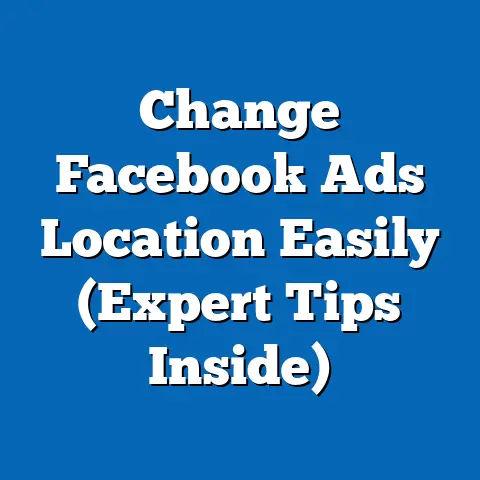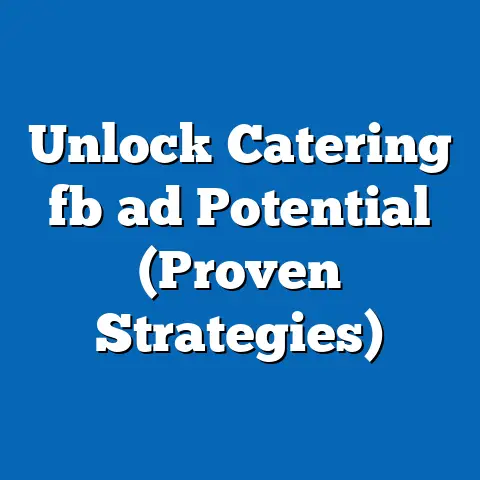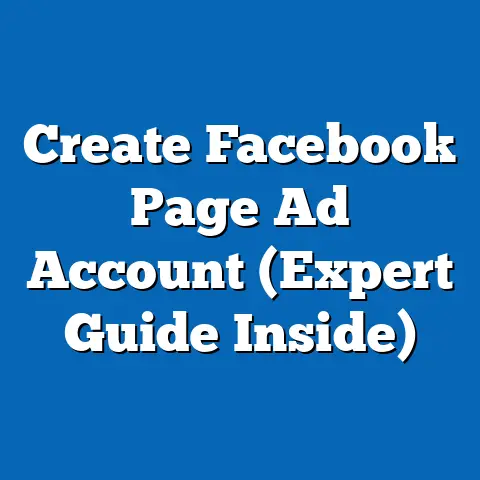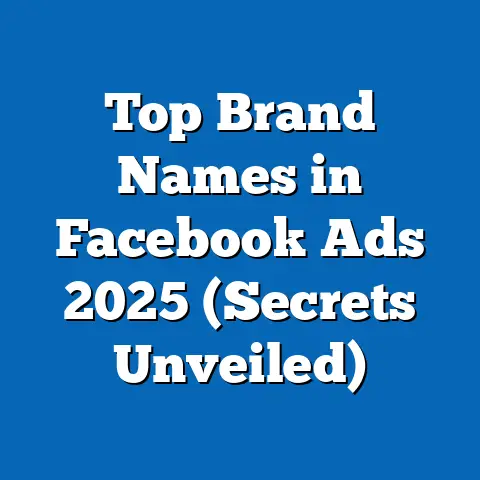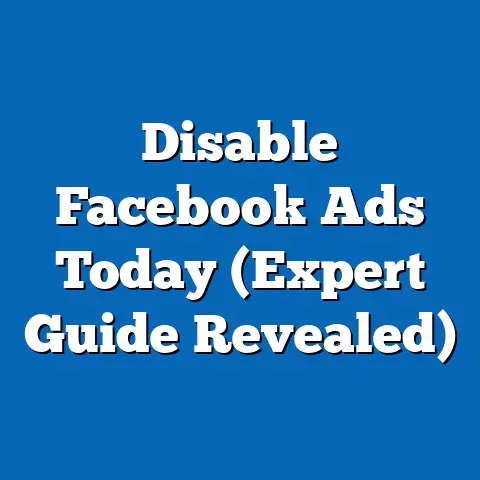Unlock the Best Facebook Ads Strategies (Pro Tips Inside)
The wind is picking up outside, rustling the leaves on the trees in my backyard. It’s that time of year again – autumn is here, and just like the seasons changing, so too must our marketing strategies. The digital landscape is in constant flux, and what worked yesterday might not work today. Think of Facebook advertising like tending a garden; you can’t just plant seeds and walk away. You need to nurture, prune, and adapt to get the best bloom. Today, I’m going to share some pro tips I’ve learned over the years that will help you unlock the best Facebook Ads strategies.
Understanding the Facebook Advertising Landscape
Facebook isn’t just a social media platform; it’s a massive advertising ecosystem. When I first started, it felt like throwing spaghetti at the wall and hoping something stuck. Over time, I learned that success requires understanding the lay of the land.
- Ad Formats: From simple image ads to engaging video ads, dynamic carousel ads, and immersive Stories ads, Facebook offers a buffet of options. I remember one client, a local bakery, who saw a huge spike in engagement when we switched from static images to short video clips showcasing their pastries being made.
- Placements: Where your ad appears matters. News Feed ads are generally more visible, but right column ads can be effective for retargeting. Instagram, of course, is a visual powerhouse. I once ran a campaign simultaneously on Facebook and Instagram, and while the Facebook ads drove more traffic, the Instagram ads generated significantly higher engagement rates.
- Audience Targeting: This is where Facebook truly shines. You can target people based on demographics, interests, behaviors, and even life events. Early on, I overlooked the power of detailed targeting, and my campaigns were broad and ineffective. But once I started drilling down into specific interests and behaviors, I saw a dramatic improvement.
- Algorithm Updates: This is the ever-moving target. Facebook’s algorithm is constantly evolving, and what worked last month might not work this month. Staying updated with these changes is crucial. I subscribe to several industry newsletters and regularly check Facebook’s Business Help Center to stay informed.
Key Takeaway: The Facebook advertising landscape is vast and ever-changing. Success requires understanding the different ad formats, placements, and targeting options, and staying updated with algorithm changes.
Crafting Compelling Ad Copy
Ad copy is your digital salesperson. It needs to grab attention, communicate value, and persuade people to take action. I’ve seen ads with stunning visuals flop because the copy was weak.
- Attention-Grabbing Headlines: You have seconds to make an impression. Use strong verbs, intriguing questions, or compelling offers in your headlines. For example, instead of “Learn about our product,” try “Discover the Secret to [Desired Outcome].”
- Effective Calls to Action (CTAs): Tell people what you want them to do. Use clear and concise CTAs like “Shop Now,” “Learn More,” “Sign Up,” or “Get Started.” I’ve found that using a CTA that directly addresses a customer’s need, such as “Find Your Perfect Fit,” performs better than a generic “Shop Now.”
- Communicate Value Propositions Succinctly: What problem does your product or service solve? Why should people care? Answer these questions clearly and concisely in your ad copy. Don’t bury the lede. One of my early mistakes was focusing on features rather than benefits.
- Use Storytelling: People connect with stories. Share a customer testimonial or a brief anecdote that illustrates the value of your product or service. I once ran a campaign for a local gym that featured before-and-after stories from members, and it was incredibly effective.
Example Breakdown: Let’s look at a hypothetical ad for a new online course:
- Headline: “Finally Master Facebook Ads: From Beginner to Pro in 30 Days”
- Body Copy: “Tired of wasting money on Facebook ads that don’t convert? Our comprehensive course will teach you everything you need to know to create profitable campaigns. Learn from industry experts and get personalized feedback. Join today and transform your business!”
- CTA: “Enroll Now”
This ad is effective because it addresses a common pain point (wasting money), offers a clear solution (a comprehensive course), and includes a compelling CTA (Enroll Now).
Example Breakdown: Let’s look at a hypothetical ad for a new online course:
- Headline: “Finally Master Facebook Ads: From Beginner to Pro in 30 Days”
- Body Copy: “Tired of wasting money on Facebook ads that don’t convert? Our comprehensive course will teach you everything you need to know to create profitable campaigns. Learn from industry experts and get personalized feedback. Join today and transform your business!”
- CTA: “Enroll Now”
This ad is effective because it addresses a common pain point (wasting money), offers a clear solution (a comprehensive course), and includes a compelling CTA (Enroll Now).
Key Takeaway: Compelling ad copy is essential for driving engagement and conversions. Focus on grabbing attention, communicating value, and using clear CTAs.
Visual Elements That Convert
They say a picture is worth a thousand words, and that’s especially true in Facebook advertising. Your visuals are the first thing people see, and they can make or break your ad.
- High-Quality Images and Videos: Blurry, pixelated images are a no-go. Invest in professional-quality visuals that are eye-catching and relevant to your target audience. I learned this the hard way when I tried to cut corners by using low-resolution images. The results were disastrous.
- Color Psychology: Colors evoke emotions. Use colors strategically to align with your brand and message. For example, blue can convey trust and reliability, while red can create a sense of urgency. One time, I was working with a wellness brand and used a predominantly green color scheme in their ads to convey a sense of health and nature.
- Composition: Pay attention to the layout and design of your visuals. Use the rule of thirds to create balanced and visually appealing compositions. Don’t clutter your images with too much text.
- Relevance: Your visuals should be directly relevant to your product or service and your target audience. A picture of a smiling family enjoying a vacation is more likely to resonate with people interested in travel than a generic stock photo.
- A/B Testing: Don’t assume you know what visuals will work best. A/B test different images and videos to see which ones generate the most engagement. I’ve been surprised countless times by which visuals perform best.
Example: For a clothing brand, you might A/B test two different images:
- Image A: A model wearing the clothing in a studio setting.
- Image B: A customer wearing the clothing in a real-world setting.
Track the performance of each image to see which one resonates best with your audience.
Example: For a clothing brand, you might A/B test two different images:
- Image A: A model wearing the clothing in a studio setting.
- Image B: A customer wearing the clothing in a real-world setting.
Track the performance of each image to see which one resonates best with your audience.
Key Takeaway: Visual elements are crucial for capturing attention and driving engagement. Invest in high-quality, relevant visuals and A/B test different options to optimize performance.
Utilizing Advanced Targeting Techniques
Basic demographic targeting is a good starting point, but advanced targeting techniques can take your Facebook ads to the next level.
- Custom Audiences: These are audiences you create based on your existing customer data. You can upload a list of email addresses, phone numbers, or website visitors to create a Custom Audience. This is incredibly powerful for retargeting. For example, you can show ads to people who have abandoned their shopping carts on your website. I have a client that uses custom audience to target customers who have recently purchased from them with ads of complementary products.
- Lookalike Audiences: These are audiences that Facebook creates based on your Custom Audiences. Facebook analyzes the characteristics of your existing customers and finds people who are similar to them. This is a great way to expand your reach and find new customers. I once created a Lookalike Audience based on my top-spending customers, and it generated a significant increase in sales.
- Retargeting: This involves showing ads to people who have previously interacted with your business, such as visiting your website, watching a video, or engaging with your Facebook page. Retargeting is incredibly effective because you’re targeting people who are already familiar with your brand. I always recommend setting up retargeting campaigns for website visitors, email subscribers, and social media followers.
- Pixel Tracking: The Facebook Pixel is a small piece of code that you install on your website. It allows you to track user behavior, such as page views, add-to-carts, and purchases. This data is invaluable for refining your targeting strategies and measuring the effectiveness of your campaigns. I always make sure the Facebook Pixel is properly installed and configured before launching any Facebook ad campaigns.
- Detailed Targeting: Facebook allows you to target people based on a wide range of interests, behaviors, and demographics. For example, you can target people who are interested in yoga, own a dog, or have recently gotten engaged. The key is to be specific and relevant. Don’t just target everyone who is interested in “fitness.” Target people who are interested in specific types of fitness, such as CrossFit, Pilates, or running.
Key Takeaway: Advanced targeting techniques can significantly improve the performance of your Facebook ads. Utilize Custom Audiences, Lookalike Audiences, retargeting, and pixel tracking to reach the right people with the right message.
Measuring Success and Adjusting Strategies
Facebook advertising is not a set-it-and-forget-it activity. You need to constantly monitor your campaigns and adjust your strategies based on performance data.
Key Performance Indicators (KPIs): These are the metrics you use to measure the success of your campaigns. Common KPIs include:
- Click-Through Rate (CTR): The percentage of people who see your ad and click on it.
- Conversion Rate: The percentage of people who click on your ad and complete a desired action, such as making a purchase or filling out a form.
- Cost Per Acquisition (CPA): The cost of acquiring a new customer.
- Return on Ad Spend (ROAS): The revenue generated for every dollar spent on advertising.
I always track these KPIs closely to identify what’s working and what’s not.
* Facebook Ads Manager: This is your command center for managing your Facebook ad campaigns. It provides a wealth of data and insights that you can use to optimize your campaigns. Spend time getting familiar with the Ads Manager and learning how to use its various features.
* A/B Testing: Constantly test different elements of your ads, such as headlines, body copy, visuals, and CTAs, to see what performs best. A/B testing is an ongoing process that can help you continuously improve the performance of your campaigns. I make sure to run at least one A/B test for every campaign I launch.
* Scaling Successful Ads: When you find an ad that’s performing well, scale it up by increasing your budget and expanding your targeting. Be careful not to scale too quickly, as this can negatively impact performance.
* Pivoting from Underperforming Ads: Don’t be afraid to kill ads that are not performing well. It’s better to cut your losses and focus on what’s working. I have a rule that if an ad doesn’t meet my minimum performance threshold after a certain period, I’ll pause it and try something new.
* Example: Let’s say you’re running a campaign to promote a new product. You notice that one of your ads has a high CTR but a low conversion rate. This suggests that your ad copy and visuals are effective at grabbing attention, but your landing page is not converting visitors into customers. You might try improving your landing page by adding more compelling copy, a clearer call to action, or a more user-friendly design.
Key Performance Indicators (KPIs): These are the metrics you use to measure the success of your campaigns. Common KPIs include:
- Click-Through Rate (CTR): The percentage of people who see your ad and click on it.
- Conversion Rate: The percentage of people who click on your ad and complete a desired action, such as making a purchase or filling out a form.
- Cost Per Acquisition (CPA): The cost of acquiring a new customer.
- Return on Ad Spend (ROAS): The revenue generated for every dollar spent on advertising.
I always track these KPIs closely to identify what’s working and what’s not. * Facebook Ads Manager: This is your command center for managing your Facebook ad campaigns. It provides a wealth of data and insights that you can use to optimize your campaigns. Spend time getting familiar with the Ads Manager and learning how to use its various features. * A/B Testing: Constantly test different elements of your ads, such as headlines, body copy, visuals, and CTAs, to see what performs best. A/B testing is an ongoing process that can help you continuously improve the performance of your campaigns. I make sure to run at least one A/B test for every campaign I launch. * Scaling Successful Ads: When you find an ad that’s performing well, scale it up by increasing your budget and expanding your targeting. Be careful not to scale too quickly, as this can negatively impact performance. * Pivoting from Underperforming Ads: Don’t be afraid to kill ads that are not performing well. It’s better to cut your losses and focus on what’s working. I have a rule that if an ad doesn’t meet my minimum performance threshold after a certain period, I’ll pause it and try something new. * Example: Let’s say you’re running a campaign to promote a new product. You notice that one of your ads has a high CTR but a low conversion rate. This suggests that your ad copy and visuals are effective at grabbing attention, but your landing page is not converting visitors into customers. You might try improving your landing page by adding more compelling copy, a clearer call to action, or a more user-friendly design.
Key Takeaway: Measuring success and adjusting strategies is crucial for maximizing your ROI. Track your KPIs, use Facebook Ads Manager to gather insights, and constantly A/B test different elements of your ads.
Conclusion
Facebook advertising is a powerful tool, but it requires continuous learning and adaptation. By understanding the Facebook advertising landscape, crafting compelling ad copy, utilizing effective visual elements, employing advanced targeting techniques, and measuring success, you can unlock the full potential of this platform. Remember to stay curious, experiment with new tactics, and never stop learning. The digital world is always evolving, and the best marketers are those who are willing to adapt and innovate. So, go ahead, implement these pro tips, and watch your Facebook ads soar!
And just like that, the wind has calmed, and the sun is starting to peek through the clouds. It’s a perfect reminder that even after a storm, there’s always a chance for brighter days – and more successful Facebook ad campaigns!

